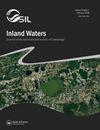新西兰奥特罗阿地区湖泊优先恢复的全国尺度营养状态分析
IF 2.3
3区 环境科学与生态学
Q1 LIMNOLOGY
引用次数: 0
摘要
由于集水区营养负荷升高、非本地物种的建立和气候变化,新西兰奥特罗阿湖的压力正在增加。目前的政府立法要求管理压力,以避免富营养化和湖泊健康退化。这种方法需要区域和全国范围内湖泊状况的信息,这是具有挑战性的,因为目前只有不到5%的湖泊受到监测。在本研究中,我们(1)利用极具代表性的数据集和湖泊特征、土地利用和环境参数作为预测变量,在全国范围内模拟了湖泊的营养状况;(2)确定了应优先保护的湖泊,以防止进一步退化。对六种统计模型进行了评估,其中极值增强产生了最高的预测能力和最低的误差。该模型表明,在数据集中的3738个湖泊中,44%为富营养或高营养状态,22%为中营养状态,34%为贫营养或低营养状态。这些数据为指导管理提供了基准,并支持为恢复新西兰奥特罗阿的湖泊提供更多资源的呼吁。为了确定需要优先保护的湖泊,我们重点关注了大约800个中营养型湖泊。我们分别用(1)保护区以外的湖泊集水区和(2)道路通道作为土地利用集约化可能性和外来物种引入可能性的替代指标。确定了170多个集水区保护有限、人类容易进入的湖泊。应立即注意保护这些水体,以防止将来需要昂贵和资源密集的补救措施。本文章由计算机程序翻译,如有差异,请以英文原文为准。
A national scale trophic state analysis to prioritize lakes for restoration in Aotearoa New Zealand
Pressures on lakes in Aotearoa New Zealand are increasing due to elevated catchment nutrient loads, establishment of non-native species, and climate change. Current government legislation requires that pressures are managed to avoid eutrophication and degradation of lake health. This approach requires information on the state of lakes at regional and national scales, which is challenging as less than 5% are currently monitored. In this study, we (1) modelled lake trophic status at a national scale using a highly representative dataset and lake characteristics, land-use, and environmental parameters as predictor variables, and (2) identified lakes that should be prioritized for protection to prevent further degradation. Six statistical models were evaluated, with extreme boosting producing the highest predictive power and lowest error. This model indicated that for the 3,738 lakes in the dataset, 44% were eutrophic or of higher trophic state, 22% mesotrophic, and 34% oligotrophic or of lower trophic state. This data provides a benchmark to guide management and supports the call for more resourcing to restore lakes in Aotearoa New Zealand. To identify lakes to prioritise for protection we focused on the approximately 800 mesotrophic lakes. We used (1) the portion of lake catchment not within conservation estate, and (2) road access as proxies for the likelihood of land-use intensification, and the introduction of non-native species, respectively. Over 170 lakes with limited catchment protection and easy human access were identified. Immediate attention should be given to protecting these waterbodies to prevent the need for costly and resource-intensive remediation in the future.
求助全文
通过发布文献求助,成功后即可免费获取论文全文。
去求助
来源期刊

Inland Waters
LIMNOLOGY-MARINE & FRESHWATER BIOLOGY
CiteScore
6.10
自引率
9.70%
发文量
34
审稿时长
>12 weeks
期刊介绍:
Inland Waters is the peer-reviewed, scholarly outlet for original papers that advance science within the framework of the International Society of Limnology (SIL). The journal promotes understanding of inland aquatic ecosystems and their management. Subject matter parallels the content of SIL Congresses, and submissions based on presentations are encouraged.
All aspects of physical, chemical, and biological limnology are appropriate, as are papers on applied and regional limnology. The journal also aims to publish articles resulting from plenary lectures presented at SIL Congresses and occasional synthesis articles, as well as issues dedicated to a particular theme, specific water body, or aquatic ecosystem in a geographical area. Publication in the journal is not restricted to SIL members.
 求助内容:
求助内容: 应助结果提醒方式:
应助结果提醒方式:


